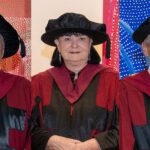Students from Curtin University have designed innovative objects that could be utilised by humans living on Mars in a new futuristic global project.
The Mars Home Planet project, developed by global technology company HP, united engineers, architects, designers, artists and students from around the world with the task of designing an urban area for one million people on Mars and then bringing it to life through virtual reality.
Mr Kim Flintoff, from Curtin Learning and Teaching at Curtin University, said the project offered a unique opportunity for Curtin students to engage in a global challenge and work with experts in visualisation technologies.
“The project was a collaborative effort to explore humanity’s future on Mars through virtual reality, requiring the resources of professionals and students to share their ideas and draft plans for an ideal smart city that could support life for one million humans,” Mr Flintoff said.
“Students from design disciplines including fashion, furniture, 3D product, jewellery and interior architecture worked on their own unique project that could one day be utilised on the Mars planet.”
One of the submitted ideas included a hammer that would be accessible in a digital or physical form by the humans on Mars and kept in an ‘object library’. The students used design techniques and technology to sculpt the personalised grip for the hammer, while being matched with engineering structures to ensure the tool had maximum strength and minimal material.
Curtin University Deputy Vice-Chancellor Academic Professor Jill Downie said the project allowed students to explore their creativity and develop an innovative design for an exciting, futuristic project.
“The Mars Home Planet project allowed students to share their knowledge and expertise in their current field, and use their imagination and creativity to design sustainable objects such as buildings, vehicles, tools and clothing,” Professor Downie said.
“The project was a fantastic opportunity for future leaders, innovators and designers across the globe to showcase their innovative ideas and techniques on a global stage.”
The students were supervised by Dr Anne Farren and Dr Qassim Saad from the School of Design and Built Environment at Curtin University.
Participants were able to access Autodesk design software to build 3D models of buildings, cities, vehicles and infrastructure, as well as HP Z Workstations and NVIDIA Quadro graphics.
Curtin University and RMIT University were also the only two Australian universities to be featured in a six-part series by the Discovery Channel on the Mars Home Planet project.
For further information on the project, visit: https://launchforth.io/hpmars/



